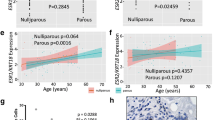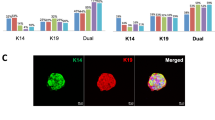Abstract
Sex steroid exposure constitutes a risk factor for breast cancer, but little is known about the effects of sex steroids on the normal breast, largely because of the lack of convenient models. We have developed a method of culturing normal breast tissue ex vivo. We have applied this method to investigate the effects of estradiol and progesterone on the key angiogenic mediator, vascular endothelial growth factor (VEGF), in the breast. Whole breast tissue was obtained from routine reduction mammoplasty. Tissue biopsies were cultured in vitro for 1–3 weeks, and the expression of luminal cytokeratin 18 was determined by immunohistochemistry. As an application, tissue biopsies were treated in vitro for 1 week with or without estradiol or estradiol and progesterone. Estrogen receptor, progesterone receptor, and Ki–67 were analyzed, and VEGF levels were examined by quantitative immunoassay and immunohistochemistry. Whole breast tissue was cultured ex vivo for 1 week with preserved morphology. Increased detachment of the luminal epithelium was observed after 2 weeks. Estradiol increased extracellular levels of VEGF in normal breast tissue biopsy medium. The addition of progesterone had neither stimulatory nor inhibitory effects on secreted VEGF. The method of whole breast tissue culturing thus provide a means by which to explore the biology of normal breast tissue. Our results suggest that estradiol exerts pro-angiogenic effects in normal breast by increasing levels of biologically active VEGF.






Similar content being viewed by others
References
Anderson E, Clarke RB, Howell A (1998) Estrogen responsiveness and control of normal human breast proliferation. J Mammary Gland Biol Neoplasia 3:23–35
Ando’ S, Panno ML, Salerno M, Sisci D, Mauro L, Lanzino M, Surmacz E (1998) Role of IRS–1 signaling in insulin-induced modulation of estrogen receptors in breast cancer cells. Biochem Biophys Res Commun 253:315–319
Beral V (2003) Breast cancer and hormone-replacement therapy in the Million Women Study. Lancet 362:419–427
Camps JL, Chang SM, Hsu TC, Freeman MR, Hong SJ, Zhau HE, Eschenbach AC von, Chung LW (1990) Fibroblast-mediated acceleration of human epithelial tumor growth in vivo. Proc Natl Acad Sci USA 87:75–79
Carlsson J, Nederman T (1989) Tumour spheroid technology in cancer therapy research. Eur J Cancer Clin Oncol 25:1127–1133
Clarke RB, Howell A, Anderson E (1997) Type I insulin-like growth factor receptor gene expression in normal human breast tissue treated with oestrogen and progesterone. Br J Cancer 75:251–257
Clarkson TB, Appt SE, Wood CE, Cline JM (2004) Lessons to be learned from animal studies on hormones and the breast. Maturitas 49:79–89
Cunha GR, Bigsby RM, Cooke PS, Sugimura Y (1985) Stromal-epithelial interactions in adult organs. Cell Differ 17:137–148
Dabrosin C (2003) Variability of vascular endothelial growth factor in normal human breast tissue in vivo during the menstrual cycle. J Clin Endocrinol Metab 88:2695–2698
Dickson RB, Lippman ME (1987) Estrogenic regulation of growth and polypeptide growth factor secretion in human breast carcinoma. Endocr Rev 8:29–43
Donjacour AA, Cunha GR (1991) Stromal regulation of epithelial function. Cancer Treat Res 53:335–364
Ferrara N, Davis–Smyth T (1997) The biology of vascular endothelial growth factor. Endocr Rev 18:4–25
Folkman J (1995) Angiogenesis in cancer, vascular, rheumatoid and other disease. Nat Med 1:27–31
Garvin S, Dabrosin C (2003) Tamoxifen inhibits secretion of vascular endothelial growth factor in breast cancer in vivo. Cancer Res 63:8742–8748
Goldfine ID, Papa V, Vigneri R, Siiteri P, Rosenthal S (1992) Progestin regulation of insulin and insulin-like growth factor I receptors in cultured human breast cancer cells. Breast Cancer Res Treat 22:69–79
Grey AM, Schor AM, Rushton G, Ellis I, Schor SL (1989) Purification of the migration stimulating factor produced by fetal and breast cancer patient fibroblasts. Proc Natl Acad Sci USA 86:2438–2442
Hanahan D, Folkman J (1996) Patterns and emerging mechanisms of the angiogenic switch during tumorigenesis. Cell 86:353–364
Hawkins RA, Thomson ML, Killen E (1985) Oestrone sulphate, adipose tissue, and breast cancer. Breast Cancer Res Treat 6:75–87
Hom YK, Young P, Wiesen JF, Miettinen PJ, Derynck R, Werb Z, Cunha GR (1998) Uterine and vaginal organ growth requires epidermal growth factor receptor signaling from stroma. Endocrinology 139:913–921
Huss FRM, Kratz G (2001) Mammary epithelial cell and adipocyte co-culture in a 3-D matrix: the first step towards tissue-engineered human breast tissue. Cells Tissues Organs 169:361–367
Hyder SM, Stancel GM (2000) Regulation of VEGF in the reproductive tract by sex-steroid hormones. Histol Histopathol 15:325–334
Hyder SM, Murthy L, Stancel GM (1998) Progestin regulation of vascular endothelial growth factor in human breast cancer cells. Cancer Res 58:392–395
Hyder SM, Nawaz Z, Chiappetta C, Stancel GM (2000) Identification of functional estrogen response elements in the gene coding for the potent angiogenic factor vascular endothelial growth factor. Cancer Res 60:3183–3190
Hyder SM, Chiappetta C, Stancel GM (2001) Pharmacological and endogenous progestins induce vascular endothelial growth factor expression in human breast cancer cells. Int J Cancer 92:469–473
Linderholm B, Tavelin B, Grankvist K, Henriksson R (1998) Vascular endothelial growth factor is of high prognostic value in node-negative breast carcinoma. J Clin Oncol 16:3121–3128
Linderholm B, Grankvist K, Wilking N, Johansson M, Tavelin B, Henriksson R (2000) Correlation of vascular endothelial growth factor content with recurrences, survival, and first relapse site in primary node-positive breast carcinoma after adjuvant treatment. J Clin Oncol 18:1423–1431
Moinfar F, Man YG, Arnould L, Bratthauer GL, Ratschek M, Tavassoli FA (2000) Concurrent and independent genetic alterations in the stromal and epithelial cells of mammary carcinoma: implications for tumorigenesis. Cancer Res 60:2562–2566
Neufeld G, Cohen T, Gengrinovitch S, Poltorak Z (1999) Vascular endothelial growth factor (VEGF) and its receptors. FASEB J 13:9–22
Picard O, Rolland Y, Poupon MF (1986) Fibroblast-dependent tumorigenicity of cells in nude mice: implication for implantation of metastases. Cancer Res 46:3290–3294
Relf M, LeJeune S, Scott PA, Fox S, Smith K, Leek R, Moghaddam A, Whitehouse R, Bicknell R, Harris AL (1997) Expression of the angiogenic factors vascular endothelial cell growth factor, acidic and basic fibroblast growth factor, tumor growth factor beta-1, platelet-derived endothelial cell growth factor, placenta growth factor, and pleiotrophin in human primary breast cancer and its relation to angiogenesis. Cancer Res 57:963–969
Rossouw JE, Anderson GL, Prentice RL, LaCroix AZ, Kooperberg C, Stefanick ML, Jackson RD, Beresford SA, Howard BV, Johnson KC, Kotchen JM, Ockene J (2002) Risks and benefits of estrogen plus progestin in healthy postmenopausal women: principal results from the women’s health initiative randomized controlled trial. JAMA 288:321–333
Ruohola JK, Valve EM, Karkkainen MJ, Joukov V, Alitalo K, Harkonen PL (1999) Vascular endothelial growth factors are differentially regulated by steroid hormones and antiestrogens in breast cancer cells. Mol Cell Endocrinol 149:29–40
Russo IH, Russo J (1998) Role of hormones in mammary cancer initiation and progression. J Mammary Gland Biol Neoplasia 3:49–61
Shekhar MP, Werdell J, Tait L (2000) Interaction with endothelial cells is a prerequisite for branching ductal-alveolar morphogenesis and hyperplasia of preneoplastic human breast epithelial cells: regulation by estrogen. Cancer Res 60:439–449
Shekhar MP, Werdell J, Santner SJ, Pauley RJ, Tait L (2001) Breast stroma plays a dominant regulatory role in breast epithelial growth and differentiation: implications for tumor development and progression. Cancer Res 61:1320–1326
Soares R, Reis–Filho JS, Gartner F, Schmitt FC (2002) Vascular endothelial growth factor, transforming growth factor-alpha, and estrogen receptors: possible cross-talks and interactions. Am J Pathol 160:381–382
Sutherland RM (1988) Cell and environment interactions in tumor microregions: the multicell spheroid model. Science 240:177–184
Yoshiji H, Gomez DE, Shibuya M, Thorgeirsson UP (1996) Expression of vascular endothelial growth factor, its receptor, and other angiogenic factors in human breast cancer. Cancer Res 56:2013–2016
Zhang HT, Scott PA, Morbidelli L, Peak S, Moore J, Turley H, Harris AL, Ziche M, Bicknell R (2000) The 121 amino acid isoform of vascular endothelial growth factor is more strongly tumorigenic than other splice variants in vivo. Br J Cancer 83:63–68
Zhuang YH, Saaristo R, Ylikomi T (2003) An in vitro long-term culture model for normal human mammary gland: expression and regulation of steroid receptors. Cell Tissue Res 311:217–226
Acknowledgements
The authors are grateful to Dr. Hans Olsson at the Department of Clinical Pathology and to the staff at the Laboratory for Experimental Plastic Surgery in Linköping for their expert assistance.
Author information
Authors and Affiliations
Corresponding author
Additional information
This study was supported by grants from the Swedish Cancer Society and Linköping University Hospital.
Rights and permissions
About this article
Cite this article
Garvin, S., Nilsson, U.W., Huss, F.R.M. et al. Estradiol increases VEGF in human breast studied by whole-tissue culture. Cell Tissue Res 325, 245–251 (2006). https://doi.org/10.1007/s00441-006-0159-7
Received:
Accepted:
Published:
Issue Date:
DOI: https://doi.org/10.1007/s00441-006-0159-7




